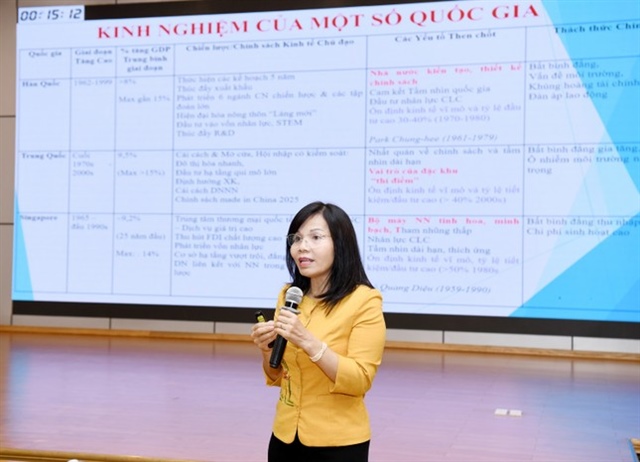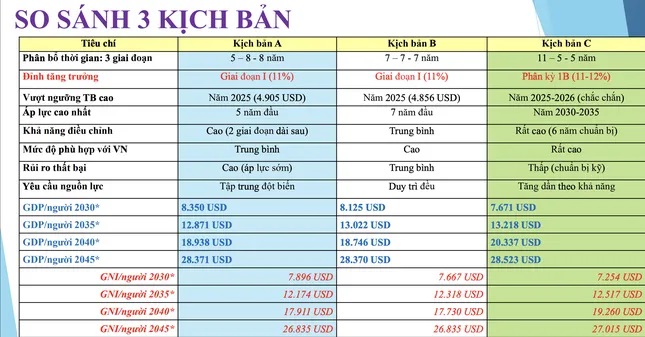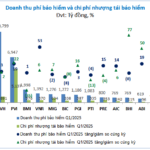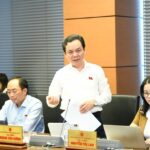Three Scenarios for 2045
At the Dialogue on Policy for High and Sustainable Economic Growth towards 2045, hosted by the National Economics University on the morning of June 3rd, experts argued that without a breakthrough acceleration phase, Vietnam risks falling into the “middle-income trap,” where growth is not strong enough to surpass the threshold of a developed economy.
 Professor Dr. Tran Thi Van Hoa proposed three growth scenarios. |
Professor Dr. Tran Thi Van Hoa from the National Economics University, citing data from the World Bank, noted that the current high-income threshold is 14,006 USD. Assuming a global average inflation rate of 3% per year, this threshold could rise to 26,835 USD by 2045. Meanwhile, with a population growth rate of 0.7% annually, Vietnam needs to achieve an average GDP growth rate of 9.5% per year to qualify for high-income status.
Dr. Hoa proposed three scenarios for growth. Scenarios A and B aim for moderate growth rates, which are easier to achieve but have limited breakthrough potential. As a result, per capita GDP by 2045 would only reach approximately 18,000 – 25,000 USD, failing to surpass the threshold for a developed country.
On the other hand, Scenario C is more ambitious, targeting an 11-12% annual GDP growth rate during the 2025-2035 period, thereby raising per capita income to 28,370 USD by 2045.
Dr. Hoa believes that this scenario is feasible if Vietnam decisively reforms its institutions, invests heavily in strategic infrastructure, upgrades its human resources, and proactively applies advanced technology, similar to the successful development model of some East Asian countries.

Experts recommend Scenario C, with a longer preparation period for comprehensive reform
|
The roadmap for Scenario C is divided into three phases. The first phase (2025-2035) serves as the foundation and acceleration period, focusing on institutional reform, infrastructure development, and attracting high-quality foreign investment. The second phase (2036-2040) aims at consolidating and transforming the growth model based on digital technology, automation, and knowledge-intensive services. The final phase (2041-2045) concentrates on perfecting the market economy, promoting innovation, enhancing sustainable development, and deepening international integration.
Proposal to Establish a “Quick Reaction Team”
Dr. Vu Sy Cuong from the Academy of Finance emphasized that finance and budget are prerequisites for achieving these goals. Mr. Cuong argued that state budget management is a critical factor influencing the implementation of policies and development plans.
“If we set numerous goals and plans, but the money doesn’t keep up, and there are no accompanying financial resources, it will be very difficult to implement any strategy. Amendments to laws related to finance and the budget are being proposed but are rarely discussed. These discussions should have been prioritized during the recent National Assembly meeting, along with deliberations on local government structures.”
Otherwise, once the apparatus is established, it will take a few more months to go back and build financial content—a delay that is concerning because almost all activities will be stagnant during this period,” said Mr. Cuong.
Associate Professor Dr. Pham The Anh emphasized that the foundation for high economic growth is macro stability. However, Vietnam’s monetary policy lacks independence. The State Bank of Vietnam is under the government’s direct control, unlike the model of an independent central bank common in many developed countries.
Mr. The Anh proposed that the National Assembly should be the body that sets the macroeconomic management targets, while the State Bank of Vietnam should have the full authority to choose the tools and methods to achieve them without government intervention. Enhancing independence and transparency will improve policy credibility, build trust, and encourage long-term investment.
In addition, the expert also warned about the significant gap between policy and implementation. While high-level directives and resolutions are considered correct, the actual implementation process is often slow and ineffective.
To address this issue, Mr. The Anh proposed establishing “quick reaction teams” to promptly receive and handle obstacles faced by businesses and people, ensuring that policies are not just on paper but are truly put into practice.
Viet Linh
– 16:49 03/06/2025
Maximizing Your Returns with Techcombank’s Auto-Wealth Service: An In-Depth Review
“Techcombank’s Auto-Profit is an exceptional financial product offering high yields of up to 4% per annum, coupled with maximum flexibility and a modern digital experience. Unlike similarly-named products in the market, Techcombank’s solution provides not only more attractive returns but also caters to the diverse needs of a wide range of customers, be it individuals or enterprises.”
AEON Locks in Investment for a Mega Shopping Center in the Mekong Delta: Over 20,000 sqm, Set to Open in 2026
AEON makes its debut in Tien Giang province with a massive 20,000 sqm shopping center, slated to open in Q4 2026. This exciting development marks AEON’s first venture into the province, and the company has wasted no time in getting started, having already acquired part of the project from the Tay Bac Group.
“Young Vietnamese Traders Embrace a Bold New Mindset in the World of Stocks and Crypto”
The pursuit of financial freedom among Vietnamese youth has led to a bold and autonomous approach to investing. They are fearlessly trading stocks, cryptocurrencies, and even derivatives, seizing the opportunity to take control of their financial destiny. However, with greater access comes heightened risk…
Unlocking $6 Quadrillion: The Key to Unlocking Vietnam’s Real Estate Conundrum
National Assembly Deputy Hoang Van Cuong has proposed a bold idea to unlock nearly VND 6 quadrillion from over 2,200 stagnant real estate projects. By addressing the challenges faced by these ventures, Cuong believes that Vietnam can harness a significant source of capital to fuel its ambitious growth target of 8% in 2025. This innovative approach has the potential to revolutionize the country’s economic landscape, offering a new avenue to fund infrastructure development and stimulate economic growth. The question now is: will this proposal gain traction and shape Vietnam’s path toward a brighter economic future?





















